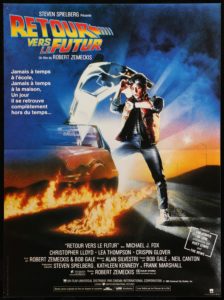1985 was a very different time and the middle of a decade of film that reverberates to this day. So many geek favorite films and franchises were completed, started, or concluded during the 80s and one of the most beloved and important was Back to the Future, the third collaboration between Steven Spielberg, already a powerhouse of genre cinema, and Robert Zemeckis. Friends for year previously their earlier two joint projects, Used Cars directed by Zemeckis and starring Kurt Russell and 1941 co-written by Zemeckis but directed by Spielberg, had performed poorly at the box office leading Zemeckis to fear that another failure would endanger their friendship. Back to the Future dominated the summer’s box office propelling Zemeckis’ career to new heights and launching a trilogy of films with groundbreaking special effects.
Marty McFly (Michael J Fox) is a teenager struggling with his own self-doubts and a family whose prospects are dim. His mother Loraine (Lea Thompson) is lost in an alcoholic fog, his father George (Crispin Glover) is bullied by a co-worker and unable to assert himself, and Marty fears failure so much he is unwilling to  really try. Marty’s strange but touching friendship with the town’s eccentric inventor Doc Brown (Christopher Lloyd) leads him to be involved with Brown’s time machine invention and eventually trapped back in the hazy and distant past of 1955 where Marty inadvertently disrupts historical events threatening his own existence.
really try. Marty’s strange but touching friendship with the town’s eccentric inventor Doc Brown (Christopher Lloyd) leads him to be involved with Brown’s time machine invention and eventually trapped back in the hazy and distant past of 1955 where Marty inadvertently disrupts historical events threatening his own existence.
Budgeted at 19 million dollars and becoming the most successful film of 1985 with a box office take of 381 million Back to the Future was a monster of a movie. In addition to Zemeckis the film helped, along with another summer movie Teen Wolf, make a star out of Michael J Fox and favored a powerful symphonic score by Alan Silvestri over the decade’s trend of using pop songs in a music video style, usually in montages. While the movie had a few popular songs and they featured heavily on the soundtrack album the film itself leaned heavily in a more traditional manner on underscoring and the symphonic sound that had returned in the 70s with prominence of John Williams’ work on Jaws and Star Wars.
While Back to the Future is a prime example of an 80s whimsical movie, heavy on fun and never in danger of taking itself too seriously with a heavy political message it is no without its own darker undertones. When we meet Loraine in 1985 she’s a woman that seems withdrawn and fearful of life a fear she is passing down to her children, but Loraine of 1955 is outgoing, confident, and unafraid of life. There is no doubt that Lorain of 1985 is a survivor of untreated trauma and while that exact nature of that trauma is never directly revealed the unsettling and threatening relationship between Loraine and George’s bully Biff, played brilliantly by Thomas F Wilson who would steal scenes with his range in the next two sequels, hints that an unspoken sexual assault hides in the unexplored familial history.
Back to the Future is a movie that plays as well in 2020 as it did in 1985 and well worth any re-watching during these dark and frightening times.
